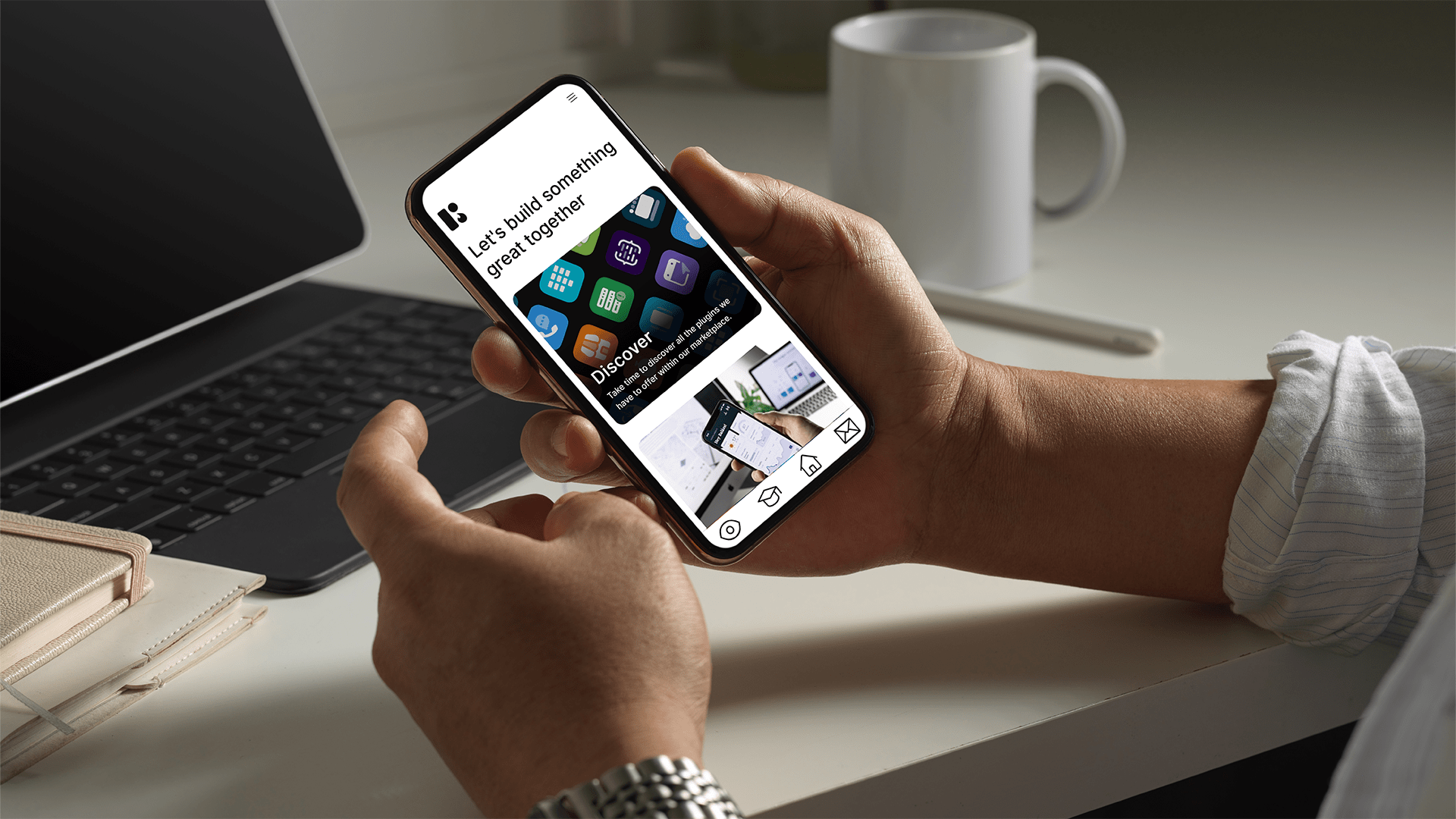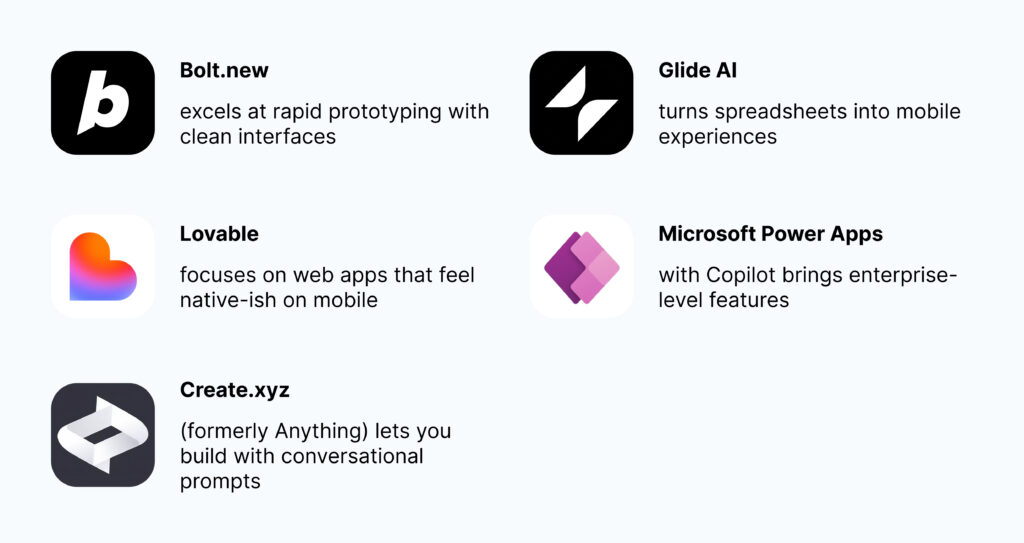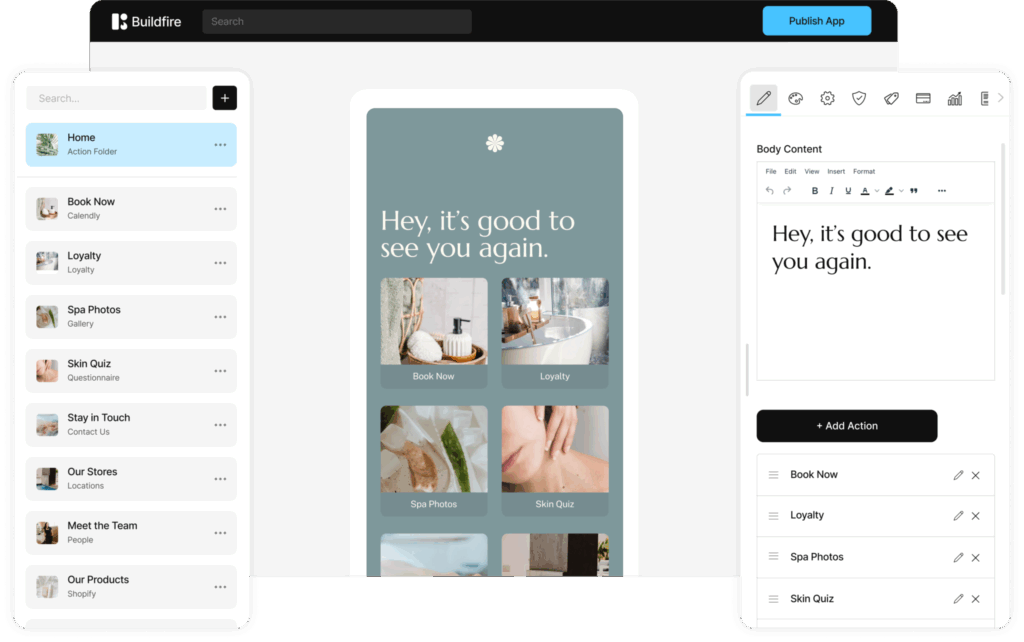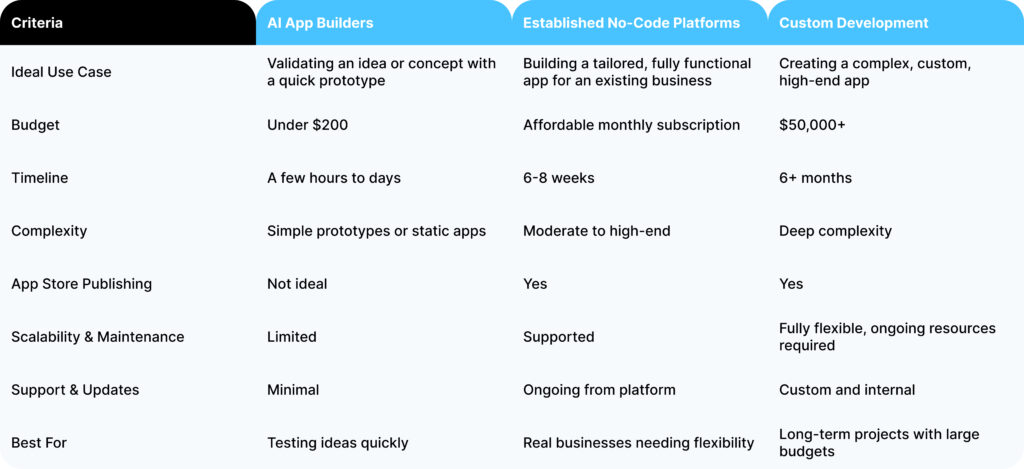
Everyone’s talking about building apps with AI in minutes, but here’s what they’re not telling you…
AI app builders are everywhere right now. Tune into YouTube, scroll through LinkedIn, or check out Product Hunt, and you’ll see dozens of tools promising to build your mobile app using nothing but natural language prompts. “Just describe your app idea,” they say, “and watch our AI bring it to life!”
It sounds incredible, right? And in full transparency, you’ll see that language on our very own homepage! The potential for AI is endless and we’re constantly finding new ways to integrate AI into Buildfire to make our platform better every day.
Some AI-first mobile app builders are genuinely impressive. Tools like Create.xyz, Bolt.new, and Lovable can generate functioning prototypes faster than ever before. The demos look amazing, the promises are bold, and the price tags are refreshingly low.
But here’s the thing: there’s a big difference between building a prototype and launching a real mobile app that users download, engage with, and rely on. After years of helping businesses bring their apps to life, we’ve learned that the path from “cool prototype” to “thriving app business” is filled with challenges that most AI app builders simply weren’t designed to handle.
That doesn’t mean AI tools are bad, quite the opposite. They’re powerful, exciting, and absolutely have their place in the app development world. But like any tool, they work best when you understand exactly what they can and can’t do.
So let’s take an honest look at the real risk vs. reward of using AI to build your mobile app, and explore when these tools make sense (and when they don’t).
The AI app promise: What’s got everyone excited
Before we dive into the limitations, let’s give credit where it’s due. The current generation of AI app builders has genuinely impressive capabilities that explain why so many people are excited about them.
Speed is the biggest game-changer. Traditional app development with agencies and freelancers can take months. But the best AI app builders can generate working prototypes in hours, sometimes minutes. That’s not marketing hype, it’s genuinely possible.
The accessibility factor is huge too. You don’t need to learn complex visual builders or understand technical concepts. Natural language programming means you can literally describe your app in plain English and watch it come to life. “I want a fitness app that tracks workouts and sends motivational notifications.” Boom, you’ve got a starting point.
Cost-wise, it’s hard to argue with free or $20/month compared to the $25,000-$500,000 that freelance developers or agencies typically cost. For bootstrapped entrepreneurs or small businesses testing ideas, that difference is everything.
The most popular AI app builders each bring something unique to the table

When you see these tools in action, it’s easy to understand the excitement. The ability to go from idea to working prototype so quickly feels like magic. But, like most things that sound a little too good to be true, there tends to be a catch.
The Reality Check: The 3 ways AI app builders hit their limits
Here’s where we need to get real about what these AI mobile app builders can and can’t do. The limitations aren’t deal-breakers for every use case, but they’re significant enough that most businesses hit them eventually.
The app store publishing problem
This is probably the biggest gap, and it’s one that doesn’t become obvious until you’re ready to launch. Most AI app builders create Progressive Web Apps (PWAs) or web-based experiences that look and feel like native apps. That’s fine for some use cases like, company news feeds, basic forms, and surveys, but it’s not the same as having a real app in the iOS App Store or Google Play Store.
Getting published in official app stores requires jumping through complex hoops: app store compliance, privacy policies, proper metadata, icon requirements, submission processes, and review procedures that can take weeks. Apple and Google have thousands of guidelines, and they change regularly. AI tools simply aren’t sophisticated enough to navigate this maze.
Even if you manage to package your AI-generated app for store submission, rejection rates are high (nearly 95% of DIY submissions fail). We’ve seen countless businesses get stuck at this stage, suddenly realizing they need help from actual humans who understand the app store ecosystem.
The user engagement challenge
Product management expert Marty Cagan points out something most people don’t realize: “real business applications have thousands of unique business rules embedded in them.” But beyond those technical rules, every business has its own distinct way of engaging with their users.
AI app builders excel at generating clean user interfaces and basic functionality, but they struggle when it comes to the sophisticated business rules or features that create meaningful user engagement. Want to build a custom loyalty rewards program? Need advanced push notification campaigns based on user behavior? Planning to add in-app chat? These scenarios require sophisticated features that AI tools simply aren’t equipped to create reliably.
The challenge isn’t just about writing code – it’s about implementing proven, battle-tested features that actually work at scale. Things like:
- Community features (forums, social feeds, user-generated content moderation)
- Gamification systems (points, badges, leaderboards, challenges)
- Advanced monetization (subscriptions, tiered access, in-app purchases)
- User analytics and segmentation (behavioral tracking, personalized experiences)
- Engagement tools (push notifications, in-app messaging, email automation)
Established no-code platforms have spent years perfecting these plugins, testing them across thousands of use cases, and ensuring they work seamlessly together.
Advanced integrations
Most businesses don’t operate in isolation. Your app probably needs to connect to existing systems: your website, email platform, payment processor, customer database, or inventory management system.
AI app builders typically work well in isolation but struggle with complex integrations. They can easily connect to simple APIs like Instagram, weather apps, and map services but customizing those connections or attempting to connect to more sophisticated integrations? That’s where you’ll hit walls.
Need to sync customer data with Salesforce? Want to trigger automated workflows in with Zapier based on app activity? Planning to connect your app to Shopify for real-time inventory updates? These enterprise-level integrations require robust authentication, error handling, data mapping, and ongoing maintenance that AI tools simply can’t provide reliably.
Established no-code platforms have pre-built, maintained integrations with major business tools. These connections are tested, documented, and supported – which means when something breaks or needs customization, you have experts who can actually help you fix it.

The no-code alternative: why proven platforms still matter
This is where established no-code app development platforms shine. Think of it like the difference between having AI write you a custom website versus using a proven platform like Squarespace.
No-code platforms like Buildfire take a different approach. Instead of generating everything from scratch, we use AI to help us curate your personalized, pre-built, tested components that you can configure and customize.
The app store publishing advantage is huge. Buildfire has helped 10,000 apps successfully launch in iOS and Android app stores. We understand the requirements, have created a publishing wizard that simplifies the workflow, and have real humans keeping an eye on your submission ensuring it gets approved without a delay.
Long-term maintenance and growth are built in. When you build on a proven platform, you’re not just getting an app – you’re getting ongoing updates, security patches, new features, and technical support. Maybe most importantly, you’re getting an entire team that’s committed to helping your app and business succeed. As your business grows, Buildfire grows with you.
Advanced features come standard. You’re passionate about creating a truly valuable app for your users – one that keeps them coming back. That’s exactly how we feel about our platform. We’re committed to delivering new, powerful, and properly tested features like push notifications, user analytics, and AI integrations so you can continue to improve your app offering.
Consider this real-world timeline comparison:
- AI app builder: Prototype in 2 hours, but 8-12 weeks (or more) to get ready to the point of publishing
- Established no-code platform: 2-8 weeks to build AND publish a fully functional app
- Custom development: 18+ weeks and $25,000-$500,000+
When you consider the entire journey of building, publishing, and managing an app, the seemingly “slower” no-code option will often get you to market faster in the end.
Making the smart choice: A decision framework
So when should you choose each approach? Here’s a practical framework based on what we’ve learned from hundreds of app projects:

The Future: AI + no-code = The best of both worlds
Here’s the exciting part: this isn’t really an either/or decision. The future of app development is combining the speed of AI with the reliability of proven platforms.
Smart no-code platforms like Buildfire are already integrating AI capabilities. Instead of replacing the entire development process, AI is being used to speed up specific tasks. At Buildfire, you can use AI to personalize the selection of plugins for your app by telling us in your own words what you want it to do. Our team of engineers and developers are continuing to harness AI to reliably help customers generate content, create layouts, write copy, create images, and more.
This hybrid approach gives you the best of both worlds: the magic and speed of AI for the creative parts, combined with the reliability and business-readiness of established platforms for everything else.
Choose Your Path Wisely
The mobile app landscape has never been more exciting or more accessible. AI app builders have democratized app creation in ways that seemed impossible just a few years ago. But like any powerful tool, they work best when you understand their strengths and limitations.
If you’re just getting started, there’s nothing wrong with experimenting with AI tools to validate your ideas and understand what’s possible. Many successful app businesses started with rough prototypes built on whatever tools were available.
But when you’re ready to build something real – something that actual users will download, pay for, and rely on – it pays to choose a no-code software that can handle the full journey from idea to thriving business.
The best app isn’t necessarily the one that gets built fastest. It’s the one that actually gets published, finds its audience, and grows into something valuable. Sometimes the “slower” path gets you there quicker.
Ready to explore your options? Start your free Buildfire trial today or connect with our team to discuss your app idea and get a walkthrough of our platform